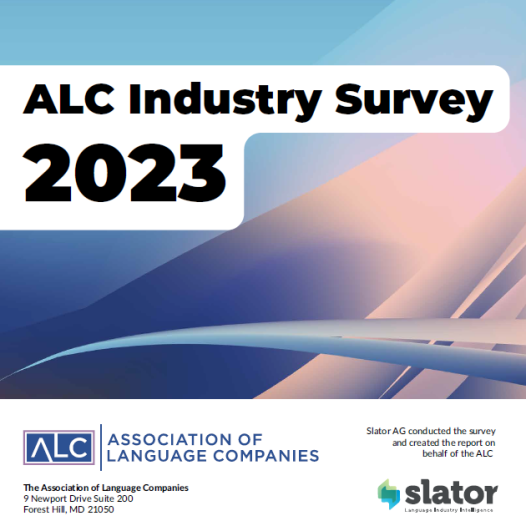
About the Association of Language Companies Annual Report
Organizations in the language service industry traditionally use a large network of independent contractors. We co-sponsored a survey with the Association of Language Companies (ALC) to learn more about how these businesses are managing their contractor workforce, with an emphasis on the challenges and opportunities they face.
The ALC Industry Report aims to provide key insights into the language service industry. For this recent survey, 85 companies in the US and globally were surveyed, with over 70% based in the US. The vast majority of respondents were owners and C-level executives, with 72% from companies with revenue of less than $5 million. The main service line for 60% of companies is translation, with healthcare being the dominant buyer sector.
Highlights from findings include:
Almost nine in ten companies cited “grow revenue” as a top business priority for 2023
Close to 80% of companies report facing a talent shortage. Sales, interpreters, and project managers top the list of roles that are in strong demand and short supply.
More than half of companies reported operational cost increases, with labor costs most affected.
Respondents on average use 767 independent contractors. Half of the companies said their biggest challenge when managing contractors is sourcing and recruiting talent, followed by onboarding at 20%.
This year’s report showed that while language services providers seek to drive growth, they face talent shortage amidst increasing operational costs. Given the importance of translators and interpreters to their business model, we will discuss the common challenges these companies face when it comes to recruiting, onboarding, paying their contractors, and how they can more effectively leverage this talent pool to scale their business.

Download the Association of Language (ALC) Industry Report
This report aims to provide key statistics and insights to the language service industry. It gathers vital data on financial performance, examines how service models vary, and builds up a broad picture of current market dynamics, including the usage of independent contractors.
How to Hire a Translator or Interpreter
Nearly 75% of the companies expect their need for independent contractor translators to increase in the next 12 months, but nearly half said their top challenge when managing contractors is sourcing talent. When asked about the biggest challenges when recruiting contractors, 44% of respondents chose ‘recruiting the contractor with the rates we need, while 32% chose ‘identifying worker that meet the criteria for specific assignments or projects.’
Figures like these highlight the importance of having recruitment strategies to attract contractors. How do you publicize open work assignments? Consider developing a webpage that advertises the types of skillsets/qualifications you are seeking, where workers can apply and be added to your talent pools based on specific criteria. As jobs become available, you can then route these assignments to the appropriate talent pools. Once workers complete jobs, do you have an internal system to identify top performers? You should consider developing tactics to ensure you are sending this “elite” group a continuous flow of assignments, and pay them a competitive rate.
Onboarding Your Translators and Interpreters
The onboarding process is crucial for ensuring that contractors meet your company’s qualifications to get to work in a timely manner. Once you’ve sourced and recruited the right qualified worker for your open job, how easy is it for them to start? With respect to onboarding, 68% of companies reported that the biggest challenge is ensuring that contractors meet the company’s screening process for credentials and qualification.
When working with independent contractors, it’s important to consider if they can quickly and intuitively have their tax IDs and bank information verified, upload important documents, submit background check requests, and choose their payment preferences. A poor onboarding experience can make it difficult to retain high quality talent, and it can also add further delays to your work getting done. You should have a systematic, automated process that allows workers to easily self-onboard, while ensuring that they meet your requirements. This system should also provide real-time visibility into your workers’ onboarding status and allow you to sort them into various talent pools based on their backgrounds, experience, etc.
Paying Translators and Interpreters
When it comes to paying independent contractors, 30% of the companies in the survey reported that their biggest challenge was being able to offer different payment options. 19% of the companies also reported that manually tracking timesheets, emails, invoice generation, and the lack of automation was the biggest challenge, while a further 19% said that paying workers located outside the company’s headquarter country was their biggest challenge.
To attract and retain talent, businesses should consider offering flexible payment options (ACH, PayPal, etc.) as well as international payment options. Furthermore, manually approving timesheets and tracking invoices adds a lot of administrative burden and could delay payment too. If you’re using a traditional payroll system that is catered to W2 employees, you’re likely to encounter obstacles with paying on a project basis and storing and tracking invoices. Consider leveraging independent contractor management systems that are built to help you pay contractors quickly, at scale, almost anywhere in the world.
Why Compliance Matters in the Language Services Industry
The laws and regulations around engaging with independent contractors frequently shift and evolve. 53% of the survey respondents reported that their organization had been impacted by new legislation between 2022-2023. Of that number, legislative changes impacting worker classification (what constitutes a W2 employee vs a 1099 independent contractor) was a top concern. Recently, the Department of Labor adopted a final ruling that will dictate how organizations should classify their workers for purposes of the federal Fair Labor Standards Act based on a six-factor test.
Any organization that manages a large number of language service contractors should work closely with their legal team to stay on top of relevant laws and regulations. In addition, having an automated system that is designed to specifically manage independent contractors could help mitigate compliance risks as well.
How Technology Can Help Language Services Providers
As the survey showed us, more and more companies will be looking to hire interpreters and translators in the coming years. Implementing an automated system to help recruit, onboard, verify, and pay these workers efficiently and compliantly can help organizations find success and the right talent.
WorkMarket by ADP is an independent contractor management system that helps businesses manage their 1099 workers separately from their W2 employees. With a versatile set of tools, organizations can streamline every aspect of the contractor lifecycle. Branded recruiting pages can be shared with your network of contractors to showcase your business and the opportunities you have to offer while allowing you to initiate onboarding and worker verification at scale. Automated onboarding tools make it easy for your workers to submit their credentials and information, while also collecting and storing essential documentation and sorting workers into your talent pools based on your pre-selected criteria. Lastly, our platform allows you to easily and flexibly pay your U.S. and international workers while maintaining invoice audit trails.
Learn more about how WorkMarket has been helping language service industry businesses scale their independent contractor workforce while maintaining compliance.


